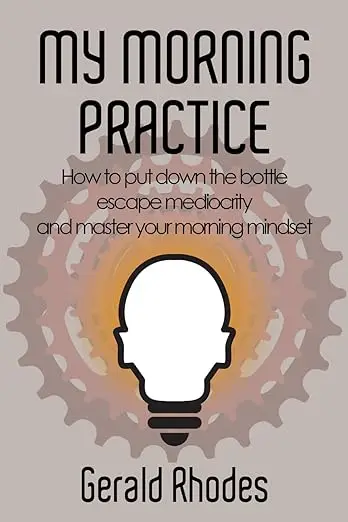
You know that feeling when your alarm goes off and you’re already behind? When you’re rushing through your morning, grabbing whatever’s closest, and feeling scattered before you even leave the house? I used to live like that every single day. My mornings were chaotic, reactive, and honestly, they set the tone for entire days that felt out of control.
But here’s what I’ve learned: you don’t need hours of free time to create an ideal morning routine that transforms your day. You don’t need to become someone who naturally bounces out of bed at 5 AM or has a perfectly organized life. You just need 30 minutes and the willingness to design a morning practice that actually works for your real life.
The best morning routines aren’t about copying what works for someone else—they’re about understanding what you need to feel grounded, energized, and ready to show up as your best self. They’re about creating a buffer between sleep and the demands of your day, a space that belongs entirely to you. The goal is to build an effective morning routine that sets a positive tone for everything that follows.
What would it feel like to start your day from a place of intention rather than reaction? What if those first 30 minutes, especially what you do first thing after waking up, could actually change everything that follows? Let me show you how to design a morning practice that fits into your busy life and helps you reclaim your mornings.
Why Your Morning Practice Matters More Than You Think
Your morning routine sets the foundation for everything that follows. When you begin your day with purpose and care, you’re not just checking boxes—you’re programming your nervous system for success. You’re telling your body and mind that you matter, that your well-being is a priority, and that you’re in control of how you show up in the world. Establishing a good morning routine helps you start the day positively, setting the tone for wellness, energy, and productivity.
I’ve noticed something powerful happens when you commit to even a short morning practice. You stop feeling like life is happening to you and start feeling like you’re an active participant in creating your days. That shift alone is worth the 30 minutes.
The science backs this up too. Consistent morning routines help regulate your circadian rhythm, reduce decision fatigue, and create a sense of stability that carries through your entire day. But more than the research, there’s something deeply nourishing about having a part of your day that’s entirely yours. As you establish your morning routine, keep your big picture goals in mind to ensure your actions align with your overarching objectives for the day and beyond.
The Foundation: Quality Rest and Consistent Wake Times
Before we design your ideal morning practice, we need to talk about what happens before you wake up. The quality of your morning is directly connected to the quality of your sleep. This isn’t about perfection—it’s about creating conditions that support you.
A good night’s sleep begins with going to bed at a consistent hour. Your body thrives on rhythm and predictability. When you keep irregular sleep schedules, you’re constantly working against your natural circadian rhythm, making every morning feel like an uphill battle.
Aim for 7-9 hours of sleep, but more importantly, aim for consistency. Going to bed and waking up at roughly the same time each day—yes, even on weekends—helps your internal clock find its natural rhythm. This single change can make waking up feel less jarring and more natural.
Here’s a gentle challenge: What time do you need to wake up to have 30 minutes for yourself before your day officially begins? Work backward from there. If you need to be out the door by 8 AM and want 30 minutes for your morning practice plus time to get ready, you might need to wake up at 6:30 AM. That means a bedtime around 10:30 PM to 11:30 PM for optimal rest. Prioritizing quality sleep not only helps you feel refreshed in the morning but also sets you up for a more productive and energized next day.
Preparing for a Productive Morning
A truly successful morning routine doesn’t start when your alarm clock rings—it begins the night before. Preparing for a productive morning means giving your body and mind the rest they need to wake up refreshed and ready to take on the day. Establishing a consistent sleep schedule is incredibly important for your overall well-being and the effectiveness of your morning routine. Try setting a gentle “go to bed” alarm as a reminder to start winding down, just as you would set an alarm to wake up.
Create a bedtime routine that signals to your body it’s time to rest. This could be as simple as reading a few pages in your favorite book, enjoying a hot shower, or spending a few quiet moments reflecting on your day. Avoid heavy lifting or strenuous activities late at night, as these can make it harder for your body to relax and fall asleep. Instead, focus on calming rituals that help you transition from the busyness of the day to a restful night in bed.
By preparing for sleep with intention, you’re setting yourself up for a productive morning. When you wake after a good night’s sleep, you’ll find it much easier to stick to your morning routine, feel energized, and approach the rest of your day with clarity and purpose. Remember, the best morning routines are built on a foundation of rest—so give yourself permission to prioritize sleep as an essential part of your routine.
Creating Your Personal Morning Blueprint
The most effective morning routines are the ones you actually stick to. This means designing something that feels sustainable, not overwhelming. Your ideal morning practice should energize you, not exhaust you before your day even begins.
Start by asking yourself: What do you need most in the morning? Do you crave movement to wake up your body? Stillness to quiet your mind? Nourishment to fuel your day? Connection to feel grounded? There’s no right answer—only what’s right for you.
Consider your natural energy patterns too. If you’re someone who needs time to slowly ease into the day, build in gentle activities like stretching or journaling. If you’re naturally more energetic in the morning, you might include light exercise or creative work.
The key is to choose activities that serve multiple purposes. Focusing on a few things—like a quick gratitude practice, setting your top priorities, or a short mindfulness exercise—can make your morning routine both simple and effective. A morning walk gives you movement, fresh air, and time to think. Journaling provides mental clarity and emotional processing. A mindful breakfast nourishes your body while creating a moment of presence.
Step 1: Wake Up Without the Snooze Button
This might be the hardest part, but it’s also the most important. When you hit snooze, you’re starting your day by avoiding the thing you need to do. Hitting snooze can disrupt your morning routine, promote grogginess, and make it harder to be productive throughout the day. You’re teaching yourself that you can’t be trusted to follow through on your commitments—even the ones you make to yourself.
Place your alarm across the room so you have to get up to turn it off. When it goes off, don’t think—just move. The first few minutes are crucial. Your brain will try to negotiate with you, but remember: you committed to this 30 minutes for a reason.
If you’re struggling with this, start smaller. Set your alarm just 10 minutes earlier and gradually work up to 30 minutes. The goal is building the habit of getting up when you planned to, not necessarily the perfect morning routine right away.
Step 2: Move Your Body Mindfully
You don’t need an intense workout to wake up your body—you just need to get your blood flowing and your energy moving. This could be gentle stretching, yoga poses, a short walk around the block, or even dancing to one favorite song.
The goal is to signal to your body that it’s time to be awake and alert. Movement also helps you connect with your physical self, which is especially important if you spend most of your day sitting or in your head. Instead of starting your morning with a long sit, try to incorporate movement to avoid remaining sedentary.
Choose movement that feels good, not punishing. This isn’t about burning calories or checking off exercise—it’s about awakening your body with kindness and attention. What would feel nourishing to your body right now?
Step 3: Nourish Yourself with Intention
A healthy breakfast doesn’t have to be complicated, but it should be intentional. After a night of fasting, it’s important to break your fast with a meal that provides real nourishment, setting a positive tone for the day.
Focus on protein, healthy fats, and complex carbohydrates when possible. This could be as simple as Greek yogurt with nuts and berries, eggs with avocado on whole grain toast, or a smoothie with protein powder and spinach. A nourishing breakfast like this can help sustain your energy levels day long.
The act of preparing and eating breakfast mindfully—rather than scarfing something down while checking your phone—is just as important as what you eat. This is time to nourish yourself, not multitask.
Don’t forget to hydrate. After 7-8 hours without water, your body needs hydration to function optimally. Keep a water bottle by your bed and drink a full glass when you wake up.
To make breakfast easier and more intentional, consider meal prep strategies such as organizing ingredients or preparing meals in advance.
Step 4: Create Mental Clarity Through Mindfulness
Your mind is probably already starting to race with thoughts about the day ahead. This is where mindfulness practices become essential. You don’t need to meditate for 20 minutes—even five minutes of intentional breathing or mindfulness can create significant mental clarity.
Try a simple breathing exercise: breathe in for 4 counts, hold for 4, exhale for 6. Repeat this pattern 5-10 times. This activates your parasympathetic nervous system and helps you feel more centered.
Alternatively, spend a few minutes journaling. Write down three things you’re grateful for, set intentions for the day, or simply dump all your thoughts onto paper to clear your mind. There’s no wrong way to do this—the goal is mental clarity and presence.
In addition, try incorporating positive affirmations into your morning routine. Saying or writing positive affirmations can boost self-confidence, motivation, and help set a positive mindset for the day.
Body scan meditation is another powerful option. Starting from the top of your head, slowly notice each part of your body down to your toes. This practice helps you feel grounded and present in your physical experience.
Step 5: Set Clear Intentions for Your Day
Before you dive into the demands of your day, take a moment to set clear intentions. This isn’t about creating a rigid schedule—it’s about identifying what matters most and how you want to show up.
Write down your top 3 priorities for the day. Not your entire to-do list, but the three things that, if completed, would make you feel accomplished and aligned with your goals. This simple practice helps you start from a place of clarity rather than overwhelm.
Consider also setting an intention for how you want to feel or who you want to be throughout the day. Do you want to be patient with challenges? Creative in problem-solving? Present with the people in your life? This kind of intention-setting helps you show up more consciously.
Making the Most of Your Time
Your morning sets the tone for your whole day, so making the most of those first 30 minutes is key to a productive morning and a balanced life. Start by designing a morning routine that fits your needs—maybe it’s a quick workout to get your body moving, a healthy breakfast to fuel your energy levels, or a few minutes of meditation to clear your mind. The goal is to create a sense of control and purpose that carries you through the day ahead.
Resist the urge to hit the snooze button, as it can disrupt your natural wake cycle and leave you feeling groggy. Instead, wake up to natural sunlight if possible, or turn on bright lights to help your body shake off sleep. Take a few minutes to stretch, breathe deeply, and gently transition into your day. This small act can make a big difference in how you feel for the rest of the day.
Use this time to set your intentions and prioritize what matters most. Write out a to-do list with your top tasks, so you can stay focused and organized. Enjoy your morning cup of coffee or tea, savor your breakfast, and give yourself a moment to simply be present. By making the most of your morning routine, you’re not just preparing for a productive day—you’re investing in your work-life balance, your well-being, and your best self. Every morning is a new opportunity to create the life you want, one intentional moment at a time.
Customizing Your Practice for Real Life
Your ideal morning practice needs to work with your real life, not against it. If you have young children, your routine might happen in 5-minute chunks between helping them get ready. It can be challenging to find enough time for your routine, so be realistic about what you can fit in. If you travel frequently, you need practices that work in hotel rooms or different time zones.
Build flexibility into your routine. Have a 30-minute version for normal days, a 15-minute version for busy mornings, and a 5-minute version for emergencies. The key is maintaining some version of your practice even when life gets chaotic. Make it a priority to spend time on yourself in the morning, even if it’s just a few minutes.
Consider your seasonal needs too. Your summer morning practice might include outdoor time, while your winter routine might focus more on creating warmth and light indoors. Honor your natural rhythms and adjust accordingly. Even small changes, like moving your reading chair to a sunnier spot, can help personalize your morning environment.
Remember, not everyone is a morning person, so it’s important to create a routine that fits your unique preferences and energy levels.
Overcoming Common Morning Challenges
Let’s be honest about the obstacles you’ll face. The snooze button will be tempting. You’ll have mornings when you don’t feel like doing any of this. You’ll question whether 30 minutes really makes a difference. This is all normal.
On difficult mornings, remember that showing up imperfectly is better than not showing up at all. If you only have time for one thing, choose the practice that makes you feel most centered. If you’re traveling, adapt your routine to your new environment rather than abandoning it entirely. If you’re a night owl and naturally more productive at night, recognize that adjusting to a morning routine can be especially challenging—acknowledge your unique rhythm and make gradual changes that work for you.
Create accountability that works for you. This might mean telling a friend about your morning practice, tracking your consistency in a journal, or simply celebrating the small wins along the way. You’re building a new relationship with yourself—be patient and compassionate with the process.
Making Your Morning Practice Sustainable
The best morning routine is the one you can maintain consistently. Start with practices that feel doable and gradually build from there. Establishing a good habit in your morning routine can set a positive tone for the day and support your overall well-being. It’s better to do 10 minutes consistently than to attempt 60 minutes and burn out after a week.
Notice what actually makes you feel good versus what you think should make you feel good. Your ideal morning practice should leave you feeling energized and grounded, not drained or stressed. If something isn’t working, adjust it.
Remember that this is an ongoing experiment. Your needs will change with seasons, life circumstances, and personal growth. Stay curious about what serves you best and be willing to evolve your practice accordingly.
Your Morning Practice Is a Gift to Yourself
Creating an ideal morning practice isn’t about becoming a different person—it’s about giving yourself the conditions to be your best self. It’s about claiming those first precious minutes of your day and using them to set yourself up for success.
You deserve to start your day from a place of intention, not reaction. You deserve those 30 minutes of care and attention. Taking time in the morning can also help you plan or prepare your lunch, making your midday smoother and supporting healthy choices. You deserve to feel grounded and prepared for whatever comes your way.
What would change in your life if you started each day feeling centered and intentional? What becomes possible when you begin from a place of self-care rather than chaos? The only way to find out is to start.
Tomorrow morning, give yourself the gift of 30 minutes. Design a practice that honors who you are and who you’re becoming. Your future self will thank you for it.



